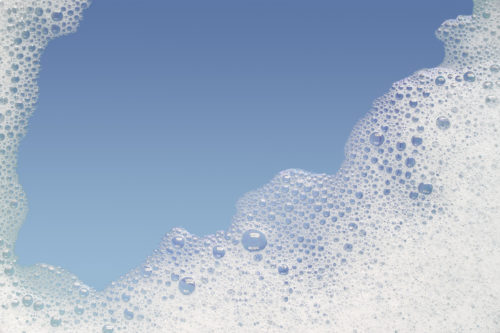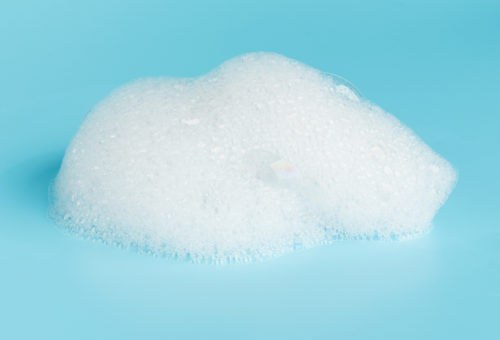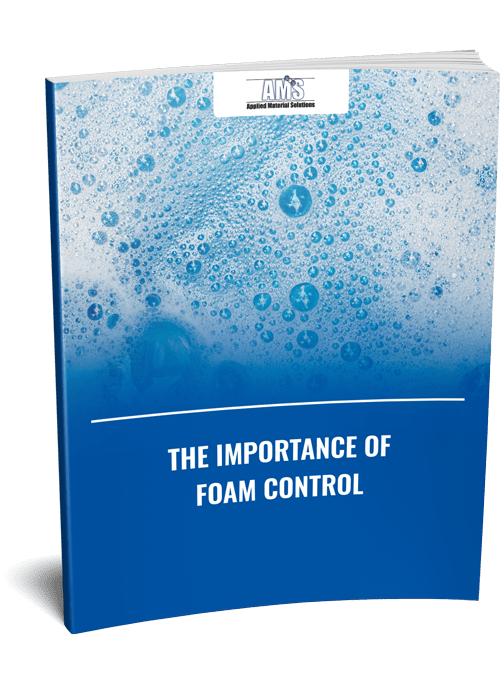For most fluid systems, foam control is a challenge to overcome. Pure liquids do not foam. In an aqueous system, contaminants such as surfactants, proteins, small solid particulates will form a stable foam in water. Foam will significantly reduce system efficiency where foam or entrained air is undesirable. To prevent foam problems and keep the process running smoothly, many applications will use an antifoam or defoamer.
What Is an Antifoam?

The chemistry of defoamers and antifoams are often similar, their main difference being timing of application. Defoamers are used to control existing foam while antifoams are used to prevent the formation of foam.
Typically, antifoams and defoamers are inert chemicals. They are comprised of a liquid, such as mineral oil, silicone, and/or hydrophobic polyol, and a hydrophobic solid, such as hydrophobic silica, ethylene-bis-stearamide, fatty acid, and/or fatty alcohol. An effective antifoam must be insoluble in the medium it is defoaming or it will not work. However, the antifoam must not be so incompatible as to cause deposition issues.
How Do Antifoaming Agents Work?
Two things are necessary for an antifoam or defoamer to work:
- An Entry Coefficient greater than zero
- A Spreading Coefficient greater than zero
These are expressed in the simple algebraic expressions below:
- E = 𝑦w/a + 𝑦w/o + 𝑦o/a
- S = 𝑦w/a – 𝑦w/o – 𝑦o/a
Where:
- 𝑦w/a = surface tension of the foaming liquid
- 𝑦w/o = interfacial tension between the defoamer and the foaming liquid
- 𝑦o/a = surface tension of the defoamer
The antifoam enters the interface between the air and the lamella, the bubble wall. The antifoam enters the bubble wall which is bridged by the antifoam droplet. This is called “bridging of the film,” and as the antifoam spreads the bubble wall is thinned. Once the antifoam has entered the lamella, a lens is formed by the antifoam on the lamella and begins to spread. The progressive spreading process reduces the thickness of the lens, the shape of which is altered by movements in the foam. Stresses occur until the lens breaks and the foam lamella ruptures. The resultant film is considerably less elastic than the surfactant film, which previously stabilized the lamella. This destabilization facilitates rupture of the lamella.
Antifoam Benefits
Foam can be highly damaging to fluid system functions and other industrial processes. It leads to operational impacts like:
- Inconsistencies in product density
- Damage to machinery or equipment used in production
- Interference with separation or coating processes, diminishing product quality
- Pump cavitation
Foam can cause problems across the entire production workflow due to downtime needed for foam related issues. Antifoams work to minimize the operational consequences of foam by preventing foam before it becomes a problem, thus saving time and money.
Antifoam Applications
Antifoams are used in a variety of applications.
Food Processing and Agribusiness
Food and agribusiness are susceptible to foam problems due to the levels of organic material processed, pressure, mixing, chemical reactions, and other process-related factors. Typical applications include:
- Grain separation and processing
- Fermentation
- Fruit and vegetable washing and processing
- Meat and poultry processing
- Dairy products, beverages, brine systems, and more
Water Treatment
Foam control is critical in maintaining the safety and efficiency of municipal and industrial water treatment facilities. Antifoams prevent air or waterborne foam from developing during numerous steps of the treatment process. Antifoams are used in applications such as:
- Aeration basins
- Boiler water treatment
- Clarifiers
- Cooling towers
- Equalization tanks
- Evaporative water treatment
- Final effluent
- Landfill leachate
- Manure pits
- Membrane Bioreactors
- Moving Bed Biofilm Reactors
- Sequencing Batch Reactors
Paint, Inks, Coatings, & Adhesives (PICA)
Foam is formed due to the rigorous mixing, grinding, and chemical reactions involved in the production of PICA materials. Unmanaged foam leads to increased production times, reduced operational efficiency, and physical product defects like craters, fisheyes, and pinholes. To prevent these setbacks, antifoam is used in applications including:
- Polymer/pigment grinding
- Package filling
- Shearing or spraying
Chemical Manufacturing
Antifoams and other foam control agents are used extensively throughout all stages of the chemical manufacturing process to regulate foam production.
Cleaning Compounds & Processes
Foam control products play a critical role in the efficacy of both the production of cleaning products and the products themselves. They are applied in different capacities in manufacturing and use of:
- Laundry detergents
- Carpet cleaners
- Personal care products
- Soap and detergent
Applied Material Solutions Antifoaming Agent
Applied Material Solutions offers silicone and non-silicone antifoam solutions for a variety of applications. Our team is here to optimize the timing, location, and frequency of adding antifoam to your process. For more information on foam formation, associated problems, and preventative measures, download our eBook now. If you need help selecting an antifoam for your process or to see samples, contact us today.





Comments are closed